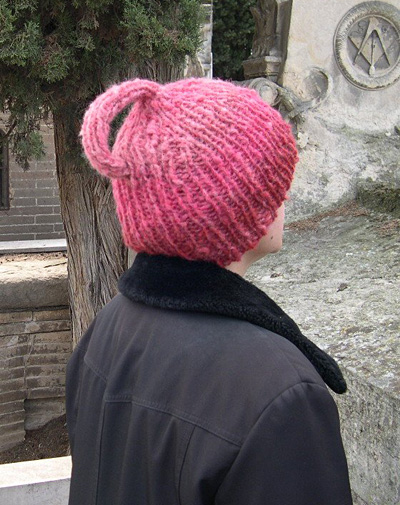
 Initial
Tube
Initial
Tube
Using double-point needles, CO 12 sts. Distribute
sts evenly between 3 needles (4 sts on each
needle) and join to begin working in the round,
being careful not to twist. Place safety pin
in work to mark beginning of round. (Move
the pin up every few rounds).
Work in 1x1 Rib until work measures 8 inches
(or longer, if desired; this tube will form
the loop which curves out from the top of
the hat).
Shape Elongated Outer Cap:
Round 1: [K1, p1, m1, place marker,
k1, p1, m1] 3 times. 18 sts.
6 sections have been formed, 2 on each needle.
Each marker indicates the end of one section;
the end of each needle indicates the end of
another section.
Round 2: Work in rib as set, working
new sts in pattern.
Round 3: [Work in rib as set to end
of section, m1] 6 times. 6 sts increased.
Repeat Rounds 2 and 3 six times more.
60 sts.
Remove stitch markers. Retain safety pin
which indicates end of round. Place a second
safety pin in the last round worked. Do not
move this pin up as you work; it is there
for measuring purposes only. This round will
be referred to as "marked round".
Note: If desired, switch to circular
needles at this point, and use a stitch marker
to mark end of round, instead of safety pin.
Work in 1x1 Rib as set until work measures
1 inch from marked round.
Side Opening:
A small vertical opening is formed in the
side of the hat by working several rows back
and forth.
Next Row: Turn work and work 1 row
in pattern as set with WS of work facing you.
You may wish to turn work inside out to do
this.
Turn work again so that RS is facing and work
1 row.
Repeat these 2 rows once more.
Resume working in the round with RS facing.
Hat Body:
Work in 1x1 Rib as set until work measures
12 inches from marked round.
Note: If you have been using circular
needles for the hat body, resume working on
double-point needles at this point. Place
20 sts on each needle, and be sure that round
begins with a k st.
Shape Rounded Inner Cap:
Work 1 round in rib as set, placing a marker
after first 10 sts on each needle. 6 sections
have been formed, as before (during outer
cap shaping).
Next Round: [Ssk, work in rib as
set to end of section] 6 times. 6 sts decreased.
Repeat this round 7 times more. 12 sts remain.
Work 3 rounds in rib as set, forming a very
short tube.
Place remaining sts on waste yarn. Break
yarn, leaving a 12-inch tail.

